Results 11 to 19 of 19
-
03-01-2017, 02:17 PM #11Senior Member



- Join Date
- Apr 2012
- Location
- Diamond Bar, CA
- Posts
- 6,553
Thanked: 3215
Use ink to see your progress, ink the bevel and do one lap on the 6k, that will tell you what is going on and if you are honing to the edge.
Until you get at least an 8k, you will not get a straight edge. A 6k will not produce a straight edge and have some chipping at the edge.
-
03-01-2017, 03:07 PM #12Junior Member

- Join Date
- Mar 2017
- Location
- Quebec, Canada
- Posts
- 5
Thanked: 0
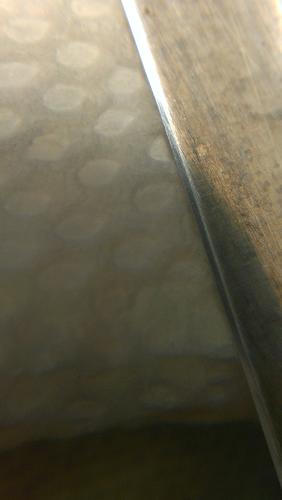
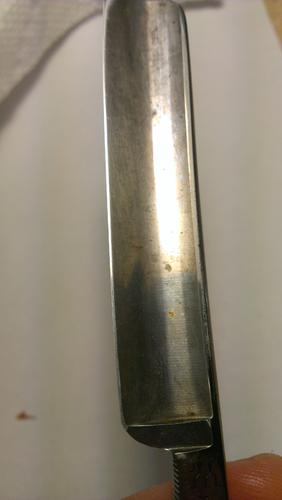
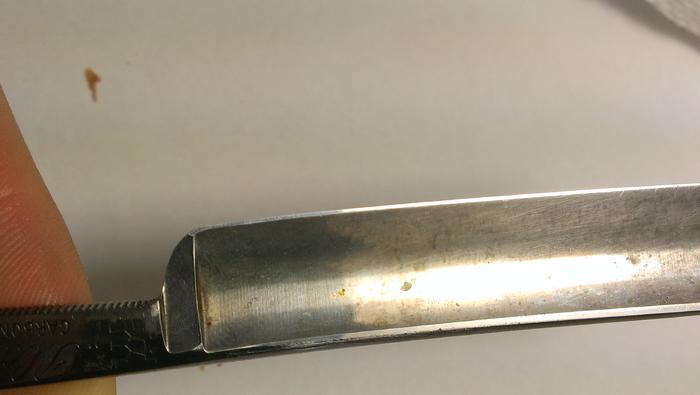
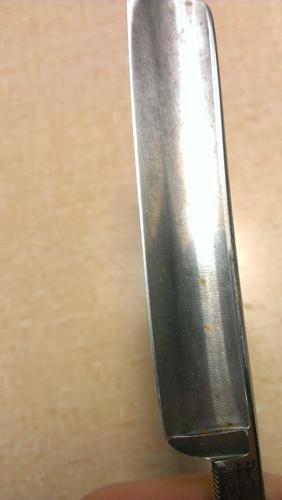
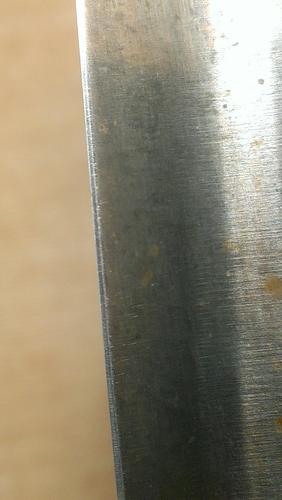
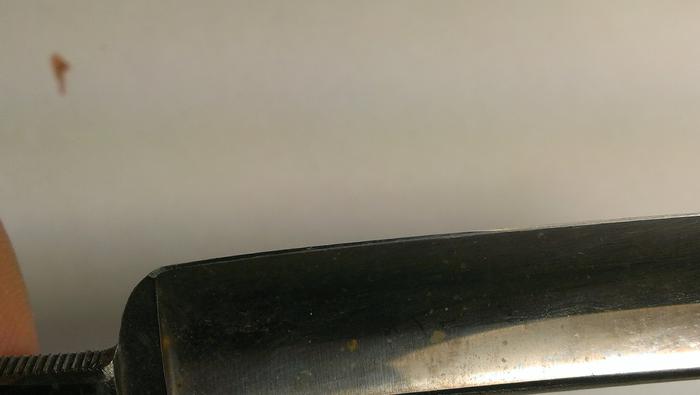
-
03-01-2017, 03:13 PM #13Junior Member

- Join Date
- Mar 2017
- Location
- Quebec, Canada
- Posts
- 5
Thanked: 0
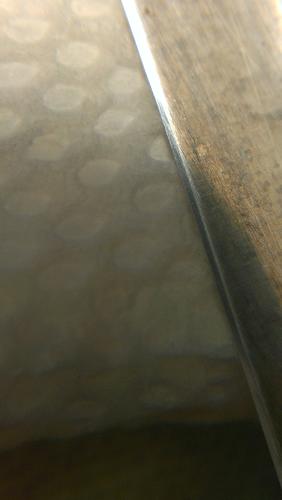
I think this is the best photo. The "darker" bevel closest to the blade edge is the one that I created when I used the 1k side for the first time. I really appreciate all of the advice. I think I will definitely use tape next time. I ordered a NANIWA 10,000 Grit "super stone". I soon realized this can become quite an expensive hobby Perhaps the 6k stone I have is simply incapable of removing microchips? I did all I could to get a photo of the chips but they are literally microscopic. I was reading other posts last night about how people saying some professionally honed blades still have micro chipping and still perform very well. I'm not too fussy, I simply want to make sure I am shaving properly and getting a true straight razor experience lol.
Perhaps the 6k stone I have is simply incapable of removing microchips? I did all I could to get a photo of the chips but they are literally microscopic. I was reading other posts last night about how people saying some professionally honed blades still have micro chipping and still perform very well. I'm not too fussy, I simply want to make sure I am shaving properly and getting a true straight razor experience lol.
Thanks again and I hope the photos will help clear things up!
**ALSO, notice the shiny "bevel" on the spine in the other pics? Is this terrible? I'm pretty sure it had a shiny worn spine like that when it arrived from Ebay. Is the spine not supposed to be flat and shiny on both sides?**
**I should also probably specify the the micro chips in question are so small that they cannot be felt by lightly running one's finger along the edge**Last edited by NewBhoner; 03-01-2017 at 03:27 PM.
-
03-01-2017, 04:30 PM #14Senior Member



- Join Date
- Apr 2012
- Location
- Diamond Bar, CA
- Posts
- 6,553
Thanked: 3215
You do have some spine wear, one or two layers of tape, will correct the angle. That the angle has changed and is lower than normal, maybe causing chipping, (the edge is too thin). So, you may now, not have a choice and have to tape, one layer may not be enough to correct the angle to where it should have been.
A 6k is not fine enough to produce a chip-free, straight edge.
Also, the heel need correcting and you are honing on the stabilizer, (see hone marks on the stabilizer at the heel and spine), and probably, creating an uneven bevel, by keeping the heel half of the razor off the stone.
Reshaping the heel will move the edge forward of the stabilizer and get the edge flat on the hone.
There is a recent post on heel correction.
-
03-01-2017, 05:21 PM #15Senior Member

- Join Date
- Nov 2016
- Location
- Chicago Suburbs
- Posts
- 1,102
Thanked: 292
The first time you hone a blade that was previously honed by someone else, you are unlikely to know whether the blade was honed with tape or without. If you know who honed the blade initially, ask them.
If not, get a Sharpie and mark the bevel of the blade. Then try to hone the edge with only a few light strokes. If the ink is removed from the entire bevel, you know you are using the same amount of tape (or no tape) that was used previously.
If there is ink remaining on the bevel where it contacts the blade, then you are using too much tape and should repeat the process with fewer layers of tape, or no tape at all.
In your case, had you tried the Sharpie test, you would have removed the ink near the blade, but at the very edge of the bevel, you would have seen ink remaining. That is why you produced a double bevel and the microchips were not removed. Repeat the Sharpie test and try additional one or more layers of tape until the ink is removed from the entire bevel.
One thing some folks use to check for microchips in the edge is a felt block. You can purchase them at some shaving stores. I have found that the small felt blankets sold for use on furniture feet and lamp bases are a suitable substitute.
If you run the edge of the razor across the corner of the felt with no pressure other than the weight of the razor itself, any microchips in the edge will catch on the felt fibers. Felt does minimal damage to the edge, but a few light strokes on your finest hone will correct any minor damage that may have occurred.
-
-
03-01-2017, 06:02 PM #16illegitimum non carborundum



- Join Date
- Jan 2008
- Location
- Rochester, MN
- Posts
- 11,552
- Blog Entries
- 1
Thanked: 3795
-
03-01-2017, 06:35 PM #17< Banned User >

- Join Date
- Oct 2016
- Location
- Saratoga, CA
- Posts
- 597
Thanked: 59
I think if he would have been directed to use a sharpie in the beginning we would not be where we are now. Using a sharpie will quickly tell you whether or not a previous user used tape on the spine, or if there are anomalies in the bevel.
Please, with any razor, either use tape or find out if you need to.Last edited by Aerdvaark; 03-01-2017 at 06:43 PM.
-
03-02-2017, 02:28 AM #18illegitimum non carborundum



- Join Date
- Jan 2008
- Location
- Rochester, MN
- Posts
- 11,552
- Blog Entries
- 1
Thanked: 3795
The wear in the spine is fine. Spine wear is kind of like an odometer. It is an indicator of how much the razor has been honed. I say "kind of" because the degree of wear can be drastically affected by the skill of the honer. The reason that I recommended that you, as a beginner, tape your spine is because of the tendency of beginners to put decades worth of wear onto a spine in a single honing session. Worse, an incompetent honer can screw up the spine by causing uneven wear in the spine. Your razor appears to still have uniform wear on the spine.
That was the good news.
The slight bad news is that you have started to hone into the stabilizer of the heel. That thicker region is more resistant to cutting by the hone so it will cause the heel end of the blade to fail to get honed properly. This can be resolved easily. With the razor flat on the back or side of the hone, lift the toe up so that only the heel's stabilizer is touching the hone. Then slightly lift the spine off the hone too. In this position, do about a dozen circles or whatever other strokes you prefer. Do the same on the opposite side of the razor. This will eliminate the prominence of the stabilizer from interfering with the honing of the heel. If it does not, then just repeat it again.
-
The Following User Says Thank You to Utopian For This Useful Post:
NewBhoner (03-02-2017)
-
03-02-2017, 02:47 AM #19< Banned User >

- Join Date
- Oct 2016
- Location
- Saratoga, CA
- Posts
- 597
Thanked: 59
Correct, because if you don't you'll end up with a hook at the end/heel of your bevel. Wish I could find a picture...
Last edited by Aerdvaark; 03-02-2017 at 02:50 AM.


 26Likes
26Likes LinkBack URL
LinkBack URL About LinkBacks
About LinkBacks






 Reply With Quote
Reply With Quote
